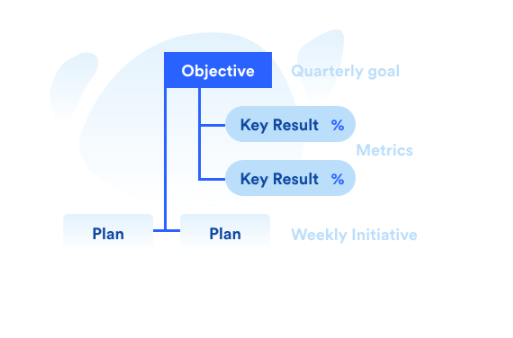Many companies use Key Performance Indicators (KPIs) to monitor their business activities. If you are trying to implement the Objectives and Key Results (OKR) method in your company, OKRs and KPIs may seem to you similar on the surface. You may wonder: do you need to abandon your KPIs? Can you use KPIs as OKRs? How do they work together?
While both KPIs and OKRs assess business performance, they actually serve different purposes. KPIs measure business performance over time, whereas OKRs align company priorities and measure progress toward future goals.
Your KPI reflects performance, but doesn’t tell you how you could improve it.
KPIs are quantifiable criteria for gauging success. Choosing which KPIs to use depends on your industry, function, company size, and your business goals. Examples of KPIs include revenue, customer satisfaction, foot traffic, employee turnover rate, among many others.
KPIs reflect the results of your actions. They measure the effectiveness of existing processes and initiatives, but they don’t tell you how you are going to grow your business or improve performance. For example, you may be determining sales performance with the following KPIs:
- Profit
- Revenue
- Cost of goods sold
- Profit margin
- Close rate
These numbers tell you how you perform after you have conducted your sales activities. You made the calls, had the meetings, and checked in with your old, new and potential customers. The KPIs show you the results post-action, but little about how you could improve the results.
Let’s say your goal is to increase the close rate by 10%. How are you going to do it? The KPI itself doesn’t give you information on that.
OKRs are your roadmap to success.
This is where OKR comes in. Not only do you know what you want to improve, but also how you are going to make it happen. You clarify success drivers and desired outcomes that support your priorities, with:
- Objectives, your ambitious, qualitative, and inspiring goals, and
- Key Results, quantifiable metrics that indicate whether you have achieved the Objective.
You can set OKRs for your company, teams, and employees. That way you can make sure your goals and actions are aligned at different levels in the company.
OKRs encompass KPIs. You can use KPIs as the basis of your Key Results. Since OKRs push you slightly out of your comfort zone to encourage action, your Key Results should be hard but not impossible to achieve.
The OKR method also makes it easier to review goals and progress in weekly meetings. Instead of relying on KPIs alone, you and your team can look at your OKRs and discuss whether you are moving in the right direction. This helps you establish a rhythm that nudges everyone in the company to celebrate success throughout the quarter and year.
OKRs and KPIs work well together.
OKRs and KPIs are not mutually exclusive. The examples below show how they can complement each other.
Example 1: Sales
Improving the bottom line is your priority for the coming quarter. You’re using the following KPIs:
- Revenue
- Profit margin
- Number of accounts
- Deal size
- Close rate
Based on your current KPIs, you expect the profit to increase by 20% by the end of the quarter. But the numbers themselves don’t tell you how you’re going to achieve this projected growth. What will drive it? How are the KPIs related to one another?
As you evaluate your strategy, you have the following insights:
- Your overarching goal is profit growth.
- The low-hanging fruit is increasing the profit margin by reducing discounts.
- Over the past several months you have been working with marketing to investigate a new market segment. You believe now is the right time to venture into it for your product line.
As your set your OKRs for the coming quarter, your Objective is:
Achieve record-breaking profit growth.
You keep the Objective qualitative so it is motivational and inspiring. You then set your Key Results based on the relevant KPIs and other desired outcomes, with estimates that challenge everyone on the team to try as hard as they can.
- Hit quarterly revenue of $3m
- Get 20 accounts in new market segment
- Decrease average discount from 15% to 7.5%
With the OKRs in mind, you can then decide on concrete projects and tasks that will help you achieve your goals.
Example 2: Customer Success
You measure the performance of your customer success team with these KPIs:
- Customer retention rate
- Average customer satisfaction score
- Adoption rate
Over the past two months there have been significant drops across these metrics. As you look into the data, you believe that the recent changes in product and marketing strategies have drawn customers that are outside your original target market, and your haven’t aligned your customer success process with the changes. You decide this will be a priority for the next quarter, so you set the Objective as
Streamline customer experience.
Your Key Results are then focused around improving these KPIs. They are outcomes essential to achieving your Objective.
- Increase customer retention rate from 85% to 95%
- Increase average customer satisfaction score from 7.5 to 9
- Increase adoption rates from 75% to 90%
KPIs reflect performance over time and are useful for evaluating ongoing activity. On the other hand, OKRs are future-oriented and drive outcomes that will contribute to your goals. If you would like to learn more about setting OKRs, check out this blog post.

